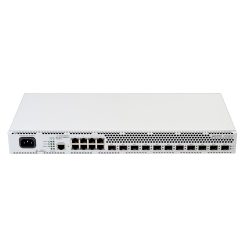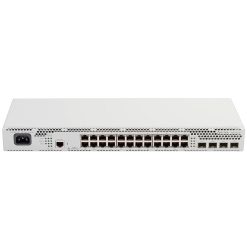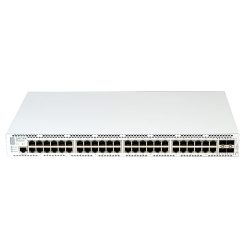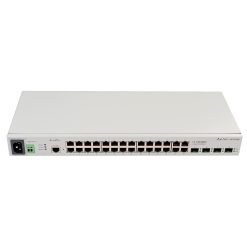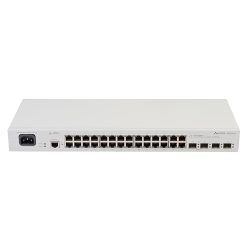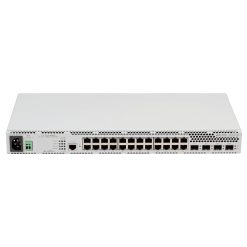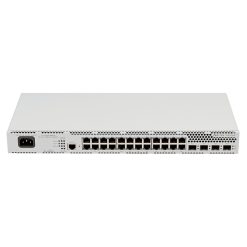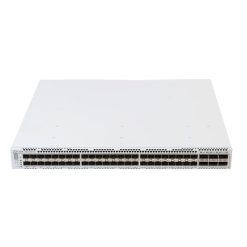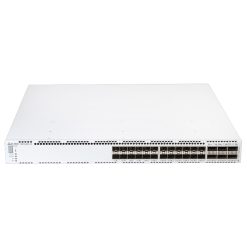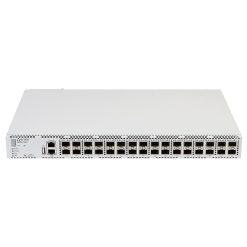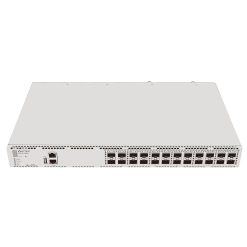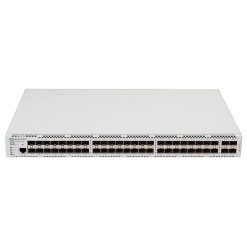| Thông số kỹ thuật phần cứng |
| Tùy chọn giao diện |
• 1GbE SFP: 24(40) (với các mô-đun mở rộng 10GbE)
• 10GbE SFP+: 24(40/72) (với các mô-đun mở rộng 10GbE/ với các cổng 40GbE cố định sử dụng cáp ngắt)
• 40GbE QSFP+: 4(12) (với các mô-đun mở rộng )
– Mỗi cổng QSFP+ cố định có thể được định cấu hình là giao diện 4x10GbE
– Mỗi cổng QSFP+ có thể được định cấu hình là cổng 40 Gbps
– Cổng USB
– Cổng bảng điều khiển
– 2 cổng quản lý: 1 RJ-45 và 1 SFP – Bộ thu phát được hỗ trợ và cáp gắn trực tiếp
– Mô-đun quang SFP+ 10GbE
– Cáp SFP+ DAC: đồng gắn trực tiếp 1/3/5 m và đồng gắn trực tiếp 1/3/5/7/10 m hoạt động
– Mô-đun quang và đồng SFP GbE
– Gắn trực tiếp QSFP+ sang SFP+ 10GbE bre |
| chuyển đổi công suất |
1,44 Tbps/1,07 Bpps |
| Cân nặng |
21,7 lb (9,84 kg) với PSU và quạt được lắp đặt |
| Kích thước (HxWxD) |
1,72 x17,36 x 20,48 inch (4,37 x 44,09 x 52,02 cm) |
| chuyển đổi chế độ |
Cắt qua và lưu trữ và chuyển tiếp |
| Dự đoán thời gian trung bình giữa các lần thất bại (MTBF) |
150.000 giờ |
| Tỷ lệ FIT dự đoán |
4,987 |
| Bộ lắp đặt giá đỡ |
Bốn tùy chọn gắn trụ linh hoạt cho giá máy chủ 19 inch hoặc giá datacom |
| luồng không khí |
luồng không khí trở lại phía trước |
| Nguồn cấp |
• Bộ nguồn kép dự phòng (1+1) và có thể cắm nóng
• Nguồn điện xoay chiều một pha 110-240 V
• Mô-đun quạt dự phòng (N+1) và có thể cắm nóng cho luồng gió từ trước ra sau và từ sau ra trước |
| Quy mô hiệu suất |
• Địa chỉ MAC trên mỗi hệ thống: 288.000
• VLAN ID: 4.091
• Số lượng LAG: 128
• Số lượng cổng trên mỗi LAG: 32 •
Quy mô FCoE: – Số lượng VLAN FCoE/kết cấu ảo FC
• Bộ lọc tường lửa: 4.000
• Các tuyến đường unicast IPv4: 128.000 tiền tố; 208.000 tuyến chủ; 64** Đường dẫn ECMP
• Các tuyến đường multicast IPv4: 104.000
• Các tuyến đường multicast IPv6: 52.000
• Các tuyến đường unicast IPv6: 64.000 tiền tố
• Các mục nhập Giao thức phân giải địa chỉ (ARP): 48.000
• Khung Jumbo: 9.216 byte |
| Thông số kỹ thuật phần mềm |
| Danh sách kiểm soát truy cập (ACL) |
• ACL dựa trên cổng (PACL): Vào và ra
• ACL dựa trên VLAN (VACL): Vào và ra
• ACL dựa trên bộ định tuyến (RACL): Vào và ra
• Mục nhập ACL (ACE) trong phần cứng trên mỗi hệ thống:
– ACL vào : 1.536
– ACL đi ra: 1.024
• Bộ đếm ACL cho các gói bị từ chối
• Bộ đếm ACL cho các gói được phép
• Khả năng thêm/xóa/thay đổi các mục ACL ở giữa danh sách (chỉnh sửa ACL)
• ACL L2-L4
• ACL IPv6
• Bộ lọc tường lửa trên vòng lặp giao diện
• Bộ lọc tường lửa trên giao diện quản lý |
| Giao thức cây bao trùm (STP) |
• Nhiều phiên bản Giao thức cây khung (MSTP): 64
• Phiên bản Giao thức cây khung (VSTP) VLAN: 253 |
| Phản chiếu giao thông |
• Sao chép cổng đích trên mỗi switch: 4
• Số phiên sao chép tối đa: 4
• Sao chép VLAN đích trên mỗi switch: 4 |
| Tính năng lớp 2 |
• STP—IEEE 802.1D (802.1D-2004)
• Giao thức Rapid Spanning Tree (RSTP) (IEEE 802.1w); MSTP (IEEE 802.1s)
• Bảo vệ đơn vị dữ liệu giao thức cầu nối (BPDU)
• Bảo vệ vòng lặp
• Bảo vệ gốc
• RSTP và VSTP chạy đồng thời
• Đường trục VLAN—IEEE 802.1Q VLAN
• Giao diện VLAN định tuyến (RVI)
• VLAN dựa trên cổng
• Địa chỉ MAC lọc
• Tạo đường hầm GRE
• QinQ**
• Dịch VLAN
• Gán địa chỉ MAC tĩnh cho giao diện
• Học MAC theo VLAN (giới hạn) • Vô hiệu hóa
học MAC
• Giao thức điều khiển tập hợp liên kết và tập hợp liên kết (LACP) (IEEE 802.3ad)
• IEEE 802.1AB Giao thức khám phá lớp liên kết (LLDP)
• Thông báo MAC
• Cấu hình lão hóa địa chỉ MAC
• Lọc địa chỉ MAC
• MAC liên tục (MAC dính) |
| Liên kết tập hợp |
• Tập hợp liên kết đa khung (MC-LAG) – Lớp 2, Lớp 3, VRRP, STP
• Nhóm trung kế dự phòng (RTG)
• Thuật toán chia sẻ tải LAG—lưu lượng được bắc cầu hoặc định tuyến (unicast hoặc multicast):
– IP: SIP, Giao thức Internet động (DIP), cổng nguồn TCP/UDP, cổng đích TCP/UDP
– Lớp 2 và không phải IP: MAC SA, MAC DA, Ethertype, VLAN ID, cổng nguồn
– Gói FCoE: ID nguồn (SID), ID đích (DID) ), ID trao đổi của người khởi tạo (OXID), cổng nguồn |
| Tính năng lớp 3 (IPv4) |
• Định tuyến tĩnh
• Chính sách định tuyến
• Giao thức định tuyến (RIP, OSPF, IS-IS, BGP, MBGP)
• Giao thức dự phòng bộ định tuyến ảo (VRRP)
• Giao thức phát hiện chuyển tiếp hai chiều (BFD)
• Bộ định tuyến ảo
• Chuyển tiếp giao thức cấu hình máy chủ động (DHCP)
• Giao thức phân giải địa chỉ proxy (ARP)
• Tính năng phát đa hướng
• Giao thức quản lý nhóm Internet (IGMP): v1, v2, v3
• IGMP rình mò: v1, v2, v3
• Bộ lọc IGMP
• PIM-SM
• Giao thức khám phá nguồn phát đa hướng (MSDP)
• Bảo mật và Bộ lọc
• Đăng nhập và mật khẩu giao diện an toàn
• RADIUS
• TACACS+
• Bộ lọc vào và ra: Cho phép và từ chối, bộ lọc cổng, bộ lọc Vlan và bộ lọc được định tuyến, bao gồm bộ lọc cổng quản lý •
Hành động của bộ lọc: Ghi nhật ký, ghi nhật ký hệ thống, từ chối, phản chiếu tới một giao diện, bộ đếm, chỉ định lớp chuyển tiếp, cho phép, thả, cảnh sát, đánh dấu
• SSH v1, v2
• Hỗ trợ ARP tĩnh
• Kiểm soát bão, vô hiệu hóa lỗi cổng và tự động khôi phục
• Bảo vệ từ chối dịch vụ (DoS) trên mặt phẳng điều khiển
• Kiểm tra ARP động (DAI)
• Địa chỉ MAC dính
• DHCP rình mò
• Bộ lọc chuyển tiếp dựa trên
• Chuyển tiếp lưu lượng quảng bá theo hướng IP
• IPv4 qua GRE (encap và decap) |
| Tính năng lớp 3: IPv6 |
• Định tuyến tĩnh
• Giao thức định tuyến (RIPng, OSPF v3, IS-IS v6, BGP v6)
• Giao thức dự phòng bộ định tuyến ảo (VRRP v3)
• IPv6 CoS (phân loại và viết lại BA, MF, lập lịch dựa trên TC)
• IPv6 qua MPLS LSP (6PE)
• ping IPv6
• Traceroute IPv6
• Giao thức khám phá hàng xóm
• Khám phá đường dẫn MTU
• SNMP, NTP, DNS, RADIUS, TACACS+, AAA
• Hỗ trợ bộ định tuyến ảo cho IPv6 unicast |
| Chất lượng dịch vụ (QoS) |
• L2 và L3 QoS: Phân loại, viết lại, xếp hàng
• Giới hạn tốc độ:
– Chính sách xâm nhập: 1 tốc độ 2 màu, 2 tốc độ 3 màu
– Kiểm soát lối ra: Cảnh sát, cảnh sát đánh dấu hành động
– Định hình lối ra: Mỗi hàng đợi, mỗi cổng
• 12 phần cứng hàng đợi trên mỗi cổng (8 unicast và 4 multicast)
• Xếp hàng ưu tiên nghiêm ngặt (LLQ), luân chuyển vòng tròn có trọng số thâm hụt được làm mịn (SDWRR), phát hiện sớm ngẫu nhiên có trọng số (WRED), giảm đuôi có trọng số
• Nhận xét 802.1p
• Tiêu chí phân loại L2: Giao diện, Địa chỉ MAC, Ethertype, 802.1p, VLAN
• Khả năng tránh tắc nghẽn: WRED
• Tin cậy IEEE 802.1p (xâm nhập)
• Nhận xét các gói bắc cầu
• Kiểm soát luồng dựa trên mức độ ưu tiên (PFC)—IEEE 802.1Qbb
• Lựa chọn truyền dẫn nâng cao (ETS)—IEEE 802.1Qaz
• Giao thức trao đổi cầu nối trung tâm dữ liệu (DCBX), DCBx FCoE và loại, độ dài và giá trị iSCSI (TLV)
• Kênh sợi quang qua Ethernet (FCoE)
• Bộ chuyển mạch chuyển tiếp FCoE (FIP rình mò Cài đặt ACL)
• Cổng kênh sợi quang ảo
• Học đường dẫn phiên FCoE
• Theo dõi tình trạng phiên FCoE
• Khởi động lại dễ dàng cho FIP rình mò
• FC-BB-6 VN2VN rình mò |
| khung gầm ảo |
• 40GbE và 10GbE dưới dạng cổng Virtual Chassis
• Lựa chọn Virtual Chassis Routing Engine (RE)
• Cung cấp trước Virtual Chassis (cắm và chạy)
• Tự động LAG hình thành các cổng Virtual Chassis
• Hỗ trợ Virtual Chassis hỗn hợp giữa EX4300-EX4600 (trong trung tâm dữ liệu chỉ)
• Quá cảnh FCoE qua các thành viên Khung gầm ảo
• QoS trên các cổng Khung gầm ảo
• Chuyển tiếp được chỉ định cục bộ
• Chuyển đổi RE duyên dáng (GRES)
• Định tuyến không dừng (NSR)
• Cầu nối không ngừng (NSB)
• Giám sát giao diện tổng hợp phân tán
• Bảo vệ mặt phẳng điều khiển cho RE ảo |
| Tính khả dụng cao |
• ISSU (trong cấu hình độc lập và MC-LAG)
• Phát hiện chuyển tiếp hai chiều (BFD)
• Phát hiện lỗi đường lên (UFD)
• Chuyển đổi công cụ định tuyến duyên dáng (GRES) trong cấu hình Virtual Chassis
• Non-stop bridging (NSB) trong cấu hình Virtual Chassis
• Định tuyến không ngừng (NSR) trong cấu hình Virtual Chassis
• Nâng cấp phần mềm không ngừng (NSSU) trong cấu hình Virtual Chassis |
| MPLS |
• VRF-Lite
• Ngăn xếp 2 nhãn
• Đường dẫn chuyển mạch nhãn tĩnh (LSP)
• Báo hiệu dựa trên RSVP của LSP
• Báo hiệu dựa trên LDP của LSP
• Đường hầm LDP (LDP qua RSVP)
• Lớp dịch vụ MPLS (CoS)
• MPLS danh sách kiểm soát truy cập (ACL)/cảnh sát
• Hỗ trợ MPLS LSR
• Đẩy, hoán đổi, bật, tra cứu IP
• Đường hầm IPv6 (6PE) (thông qua đường trục MPLS của IPv4)
• Vận hành, Quản trị và Bảo trì MPLS (OAM)—
• LSP ping
• IPv4 L3VPN (RFC 2547, 4364)
• Ethernet-over-MPLS (mạch L2)
• VPN lớp 3 (L3VPN)
• VPN lớp 2 (L2VPN)
• Bảo vệ liên kết
• Định tuyến lại nhanh MPLS (FRR)- Bảo vệ 1:1
• Liên kết nút sự bảo vệ |
| Phản chiếu giao thông |
• Dựa trên cổng
• Cổng LAG
• Dựa trên VLAN
• Dựa trên bộ lọc
• Phản chiếu tới cục bộ
• Bộ phân tích từ xa cục bộ/L2 (SPAN, RSPAN cho các khung IPv4 và IPv6)
• Phản chiếu tới các điểm đến từ xa (L2 qua VLAN)
• Công nghệ Insight (microburst giám sát và báo cáo thống kê) |
| An toàn và Tuân thủ |
| Chứng nhận an toàn |
• CAN/CSA-C22.2 Số 60950-1 (2007) Thiết bị Công nghệ Thông tin—An toàn
• UL 60950-1 (2nd Ed.) Thiết bị Công nghệ Thông tin—An toàn
• EN 60950-1 (2005) Thiết bị Công nghệ Thông tin— An toàn
• IEC 60950-1 (2005) Thiết bị Công nghệ Thông tin— An toàn (Độ lệch của tất cả các quốc gia): Báo cáo Đề án CB.
• EN 60825-1 +A1+A2 (1994) An toàn của sản phẩm laser—Phần 1: Phân loại thiết bị
• GR-63-Core (2006) Thiết bị mạng, Hệ thống tòa nhà (NEBS) Bảo vệ vật lý
• GR-1089-Core (2006) EMC và An toàn Điện cho Thiết bị Viễn thông Mạng
• SR-3580 (1995) Mức tiêu chí NEBS (Mức 3) |
| Chứng nhận tương thích điện từ |
• FCC 47CFR, Phần 15 Loại A (2009) Hoa Kỳ Phát thải bức xạ
• EN 55022 Loại A (2006)+ A1 2007 Phát thải bức xạ Châu Âu
• VCCI Loại A (2007) Phát thải bức xạ Nhật Bản
• BSMI CNS 13438 và NCC C6357 Đài Loan Phát thải bức xạ
• AS /NZS CISPR22:2009 |
| Thuộc về môi trường |
• Giảm thiểu các chất độc hại (ROHS) 5
• Telco
• Mã nhận dạng thiết bị ngôn ngữ chung (CLEI) |
| phạm vi môi trường |
• Nhiệt độ hoạt động: 32° đến 104° F (0° đến 40° C)
• Nhiệt độ bảo quản: -40° đến 158° F (-40° đến 70° C)
• Độ cao hoạt động: lên đến 2.000
• Độ ẩm tương đối hoạt động: 5% đến 90% (không ngưng tụ)
• Độ ẩm tương đối không hoạt động: 0% đến 95% (không ngưng tụ) |
| viễn thông |
Mã Nhận dạng Thiết bị Ngôn ngữ Chung (CLEI) |

















